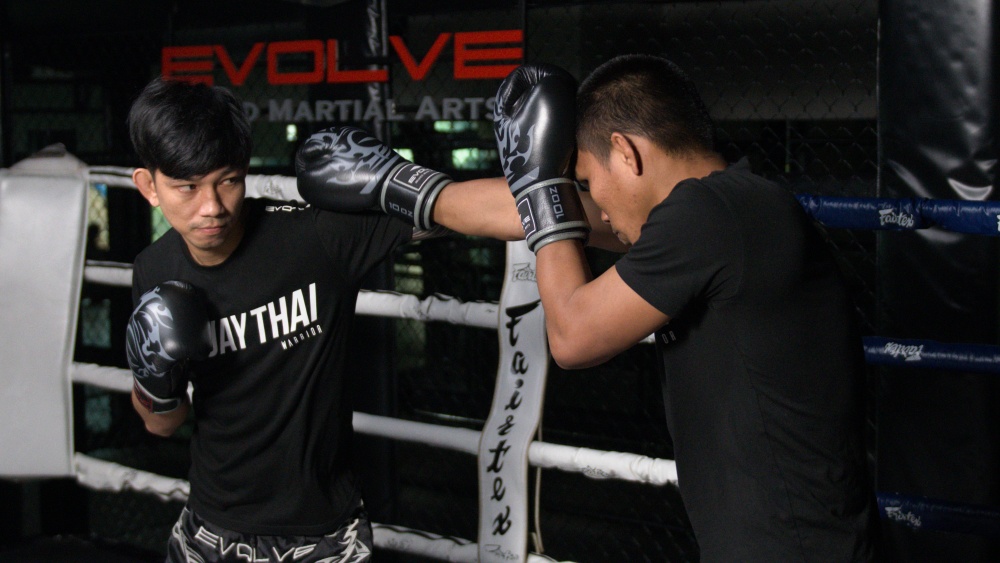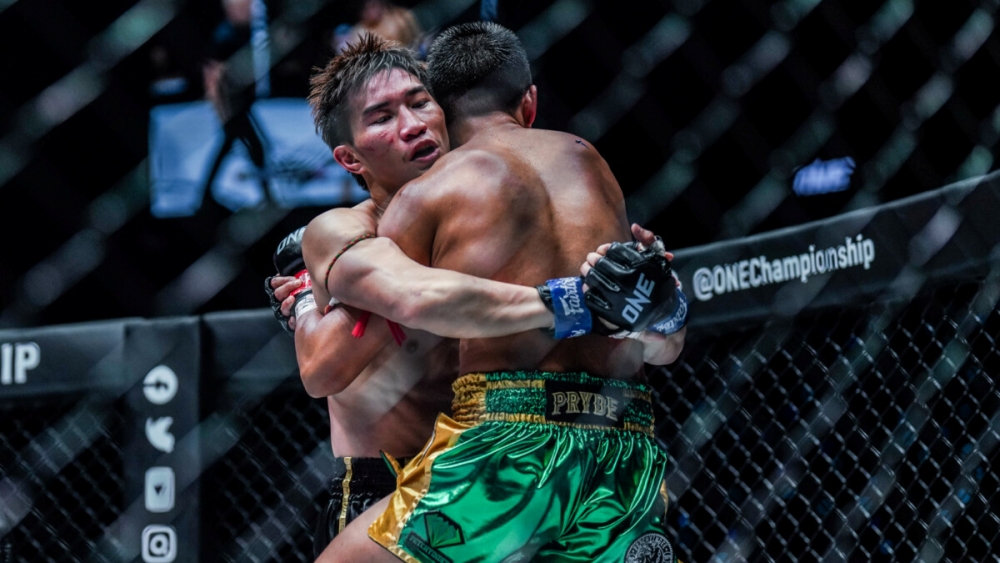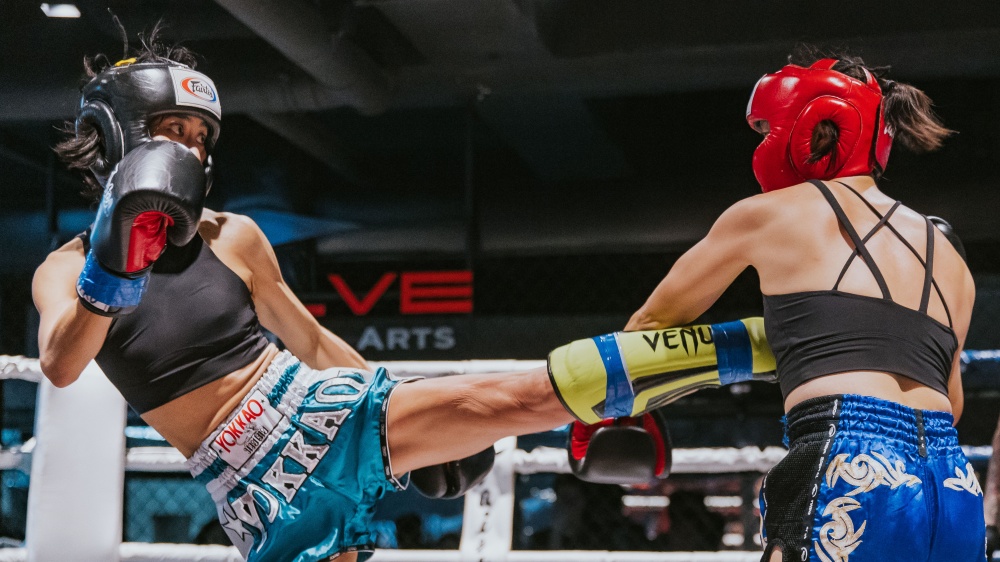In Muay Thai, one of the key defensive techniques used is the long guard. This defensive technique helps you protect yourself from incoming strikes, set up counterattacks, create and maintain distance, and helps to control the fight’s pace.
In this complete guide to the Muay Thai long guard, we will cover everything you need to know about this essential technique. We will break down the mechanics of the long guard, explain how and when to use it, and provide tips to get comfortable using it.
Basic Stance And Hand Positioning
In its simplest form, the long guard has two hand components: the front and rear hand positions. The guard can be performed from either an orthodox or a southpaw fighting stance.
Moving into the long guard from a shell guard, the lead hand is extended forward, with the arm fully stretched out and the hand at eye level. The rear hand is also extended out and away but closer to the face and body, providing additional protection for the chin and midsection. You won’t be standing waiting in this position, but once your opponent moves then you will transition into it.
What The Long Guard Is Good For
When you’re fighting an aggressive forward-charging opponent and you’re needing to create some space, this is the perfect time to go into the long guard. By creating space you can utilize footwork and angles to avoid kicks and punches as well as set up for countermoves.
You will either initiate the long guard in place, for example, if you’re up against the ropes, or you will simultaneously use it along with a reverse shuffle. Creating distance between yourself and your opponent will be an ongoing theme with the long guard.
One strategy in a fight is about setting up your opponent, moving through their defense, and initiating an offensive move to either score points or knock your opponent out. The long guard can be used both defensively and used to set up an offensive attack.
Defense, Offense, And Countering From The Long Guard
The Muay Thai long guard can be an effective defensive tool, but it can also be utilized for offense and counterattacks. From the long guard, teeps and elbows can be thrown either as a counter, or when your opponent closes in on you.
Defensively, the long guard can be used to keep an opponent at bay, preventing them from closing the distance and landing strikes. It can also be used to block straight punches and hooks by using the lead arm to absorb the impact of the strike. Additionally, the rear hand can be used to block body shots, as well as trap kicks and set up sweeps.
Combining the long guard and a reverse shuffle keeps your opponent at a distance, this is particularly effective and useful against an aggressive puncher. It is easier to deflect or parry punches from the long guard.
The Muay Thai long guard is a highly effective defensive tool against various strikes, including the left hook, left body hook, and straight punch. By extending the lead arm, you can keep your opponent at a safe distance and block incoming strikes with your rear elbow, while also keeping your lead arm up to cover your chin.
This technique not only defends against the opponent’s attacks but also creates opportunities for you to counter with powerful elbow strikes from either arm. The long guard is a versatile technique that is useful in both defensive and offensive situations.
In addition to its defensive capabilities, the Muay Thai long guard can also be used for offensive moves. For example, you can use the long guard to pull down your opponent’s lead arm, leaving their head open for a lead hand hook or a vertical elbow strike.
You can also use the long guard to set up knee strikes by pulling your opponent’s arms down and stepping in. From the long guard position, you have the option to throw various strikes such as shuffle jabs, straight right crosses, uppercuts, elbows, kicks, and knees, allowing for a diverse range of attacks.
Practicing The Long Guard
Practicing is essential to mastering a technique, and the long guard is no different. You will need to utilize every opportunity to play with the long guard and make it part of your box of tools.
Here’s how you can practice and drill the long guard:
- Shadowboxing: You can work on the transitions into the long guard while you are shadowboxing. While practicing your footwork, practice getting into the long guard.
- Bag Work: Using the heavy bag to add some resistance to your lead hand will help with entering the long guard under a bit of pressure. Push the bag and on its return use the lead hand to stop the bag.
- Sparring: This will be by far the best way to practice the Muay Thai long guard. While you are sparring you can incorporate it into your defense and practice the counters as well.
Sparring will allow you to work through the different guards and blocks that you can use from the long guard. Parrying, deflecting, catching a leg, moving in for a clinch, and a throw can be done for the long guard.
Common Mistakes
The biggest mistake of any defense is to only have one to rely on. Even if the long guard is one of the go-to defense techniques in Muay Thai, it is very important to understand and use the different variations to keep from getting your defense picked apart and eventually having it compromised.
You are going to need to use the long guard in all of its variations during a fight. Both hands extended, the rear hand closer to the body, the Dracula guard, or any one of the varying rear hand positions that you can use to guard.
The Benefit Of The Long Guard
In conclusion, if it had to be boiled down to the one benefit of the long guard, it would be to create distance between you and your opponent. But as you can see, defense and distance are only part of what makes the Muay Thai long guard effective.
Once you have this tool in your arsenal you can modify it for each and every opponent. You can use it against their attack and break through their defensive weaknesses with it, which will allow you a counter out of the long guard to score the winning points.
You may also like:

















